I didn’t have the pleasure of discovering Robert E. Howard’s Conan the Cimmerian through creased and sun damaged paperbacks from the 1970s as I’m sure many did. As I mentioned in my first post on Conan, I’m not sure whether it was the movie or the short-lived cartoon series that is the subject of this post. I know I would eagerly watch anything with Arnold Schwarzenegger and most other action stars growing up but at the same time, my parents wouldn’t let me watch just anything so I don’t recall what year I would have been allowed to watch that film.
Whatever the truth is, Conan the Adventurer was certainly one of my earliest introductions to Robert E. Howard’s most popular character. The show originally broadcast in late 1992 and had a longer second and final season in late 1993 but I don’t believe I watched it until a year or two after the original run. I learned in preparing for this review that it was followed by an even more short-lived successor titled Conan and the Young Warriors as well. It was produced by Sunbow Productions which is the same company behind G.I. Joe: A Real American Hero, The Transformers and other cartoons that doubled as toy commercials — Conan the Adventurer was no exception here either. While having no knowledge of the source material, it was one of the more memorable cartoons of my childhood though admittedly less fondly remembered than the original Teenage Mutant Ninja Turtles series and both the X-Men and Spider-Man animated series’ which all ran around the same time.
I had originally planned to watch the entire series in preparation for this post but it hasn’t aged so well that I would be willing to sit through more than twenty hours of it. I did however watch through the first season which is only thirteen episodes long. I also watched the final episodes and along with my vague childhood memories, this should be more than enough to judge what is a typically formulaic children’s cartoon. I don’t merely want to spout off factual information which can be obtained more easily by reading its Wikipedia entry but instead share my thoughts and compare it to the source material.
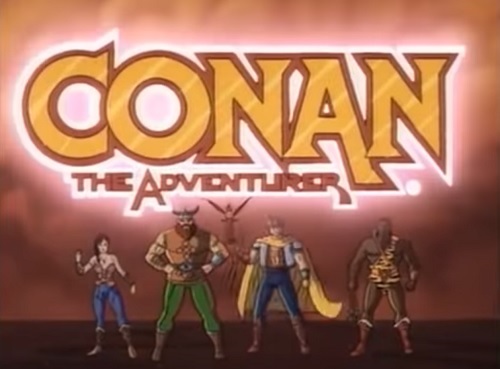
Jezmin, Snagg, Greywolf and Zula
As this was an animated show aimed at children, it has none of the violence present in Howard’s stories and other adaptations of his work. It retains the sword and sorcery aesthetic but as with similar cartoons, the characters find creative ways to not use their deadly weapons to stab, slice or maim the opponents they encounter. Other contemporary cartoons got around this by making most enemies robots — which isn’t an option in the Hyborian Age. The neat solution is achieved through a substance known as Star Metal which comes from meteors that fell to earth that Conan himself discovered. His father is a blacksmith who forged weapons with this metal until he is turned to stone with Conan’s mother and grandfather by the series protagonist Wrath-Amon. Wrath-Amon is the servant of the serpent god Set from Stygia and is himself a serpent man similar to those found in the Kull story The Shadow Kingdom. The serpent men are all vulnerable to Star Metal as if exposed to it, they will be returned to the Abyss where Set himself is trapped. So most enemies Conan and his friend encounter are magically whisked away instead of sliced into bloody strips of flesh when they come into contact with their weapons. When other enemies are encountered, the characters usually get in close to wrestle, kick or toss them away. This will obviously disappoint purists but the show certainly wasn’t aimed at them and got around the problem of avoiding the violence present in the short stories satisfactorily enough.
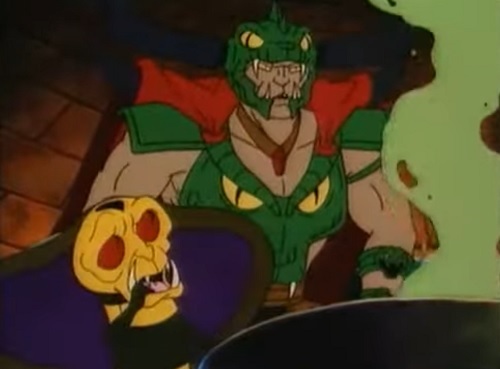
Wrath-Amon and Dregs
Conan himself is mostly recognisable though he also had to have changes made most notably with his willingness to kill and steal found especially in the stories set in his younger years. The chronology of the series means this is the young Conan and he is mostly (though not always), wearing nothing but a loincloth as indeed he did in a number of Howard’s tales. It would be too far to call this portrayal politically-correct but his morality is certainly more modern than Howard’s. He never seeks to enrich himself and though he isn’t above a barfight, he won’t kill anyone no matter how evil. He is also noticeably dumber as well as more naïve than the real Conan and this is sometimes played for comic effect. This comes into how he fights as he usually throws himself into action when the real Conan was large but also extremely quick and skilled with weapons. Conan was no scholar but he was still intelligent and had a ready store wisdom gained both from experience and his harsh upbringing. This Conan does show the same healthy interest in women though this never goes further than a brief embrace and consistent with the real Conan, he is occasionally fooled by a pretty face. He does also still utter the name of the indifferent Cimmerian god Crom in surprise or frustration and use “dog” as an insult. His main drive throughout is always to save his family which is not directly relevant to each episode but is always in the background. The character is at least close enough to the source material that viewers can see the appeal.
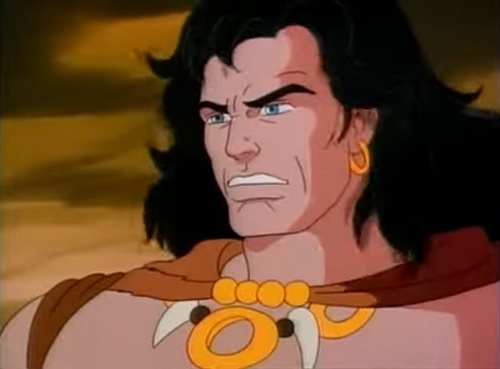
Conan
Conan’s friends are all original to the show and are met over the course of the first season. The first Conan meets is Zula, a black man from a tribe called the Vassai who has the power to communicate with animals. In the show the Vassai are from Kush which is where blacks were found in Howard’s stories. His character is a walking stereotype and would never pass the censors today. Conan next meets Jezmine, a female circus acrobat who uses shuriken made of Star Metal. She is initially a little girl-bossy but quickly warms to Conan and is occasionally made the damsel in need of rescue too. She is amusingly refused passage on a ship one early episode and told to get back to her cooking which doesn’t phase Conan. The next is Snagg who looks like and can best be described as a Viking. He has a similar temperament and build to Conan so there first introduction isn’t a pleasant one but they quickly grow to be friends. Then there is Greywolf who is a wizard that Conan meets on his way to his city Xanthus. In the same episode his brother and sister are transformed into wolves and Greywolf accompanies Conan in the hopes of being able to restore their human forms. Last to be introduced is Falkenar who has a Star Metal whip and commands a pet falcon. All characters either possess or acquire a Star Metal weapon to use against the Serpent Men. These characters don’t appear in every episode but at least one of them is usually travelling with Conan on his adventures.
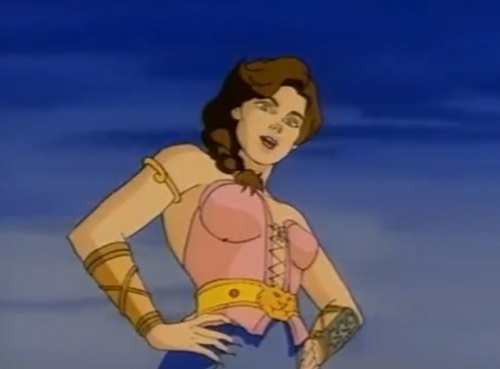
Jezmine
There are other characters that appear from time to time and even a few of Howard’s own. One I did not mention who is introduced in the first episode is the young talking phoenix named Needle. It was typical of cartoons of the time (and perhaps still is), to have an annoying side character which is certainly true of Needle. He spends most of his time as an image on Conan’s shield but pops out from time to time when called or when the plot demands it. Though annoying, he appears infrequently enough that he remains tolerable. The antagonist Wrath-Amon also has an annoying sidekick in the form of Dregs the Nāga. He is the typically cowardly minion and sometimes the target of Wrath-Amon’s… wrath when his latest scheme fails by the twenty minute mark.
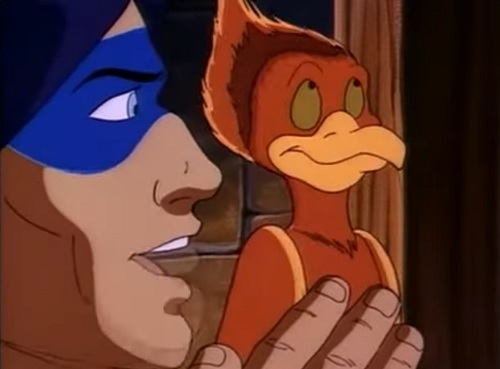
Greywolf and Needle
The episodes generally adhere to the same formula as in most cartoons and sitcoms but there are exceptions. Some move forward Conan’s overarching quest and the series finale is a three part story. The writers varied in the first season but became more consistent in the second season with the same writer Jean Chalopin listed for every episode though also including co-writers on many episodes. Some use elements, events or characters from Howard’s stories. As an example, the third episode which introduces Jezmine, Star of Shadizar, combines elements from both the The Tower of the Elephant and Rogues in the House. Nabonidus and the the ape monster Thak from the latter appear in the tower of the former but there is not much more depth than that. Then there is an episode where Conan confronts and defeats Medusa (who is oddly male), in place of Perseus. Yet another episode which is in the first season, has Conan encountering and being trained by a group of ninjas in order to help them. At the time it was made pretty much everything had to include ninjas. Then there is the episode where Conan meets and befriends a group of Picts which Howard’s Conan would have had great difficulty believing.
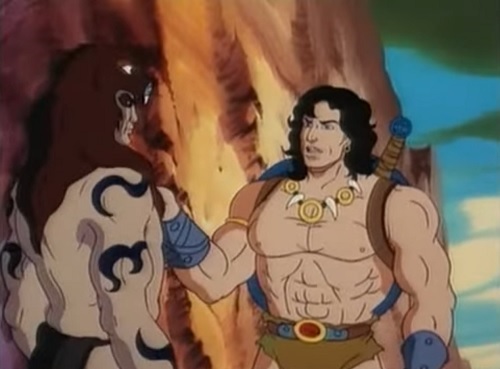
Conan befriending a Pict chief
Though as mentioned, I didn’t watch every episode, I did check a few other episodes. There is one later episode called The Frost Giant’s Daughter which is the exact title of Howard’s worst Conan story but it is mostly just the name. Valeria does make an appearance in an episode called The Red Brotherhood but this is no Red Nails and her appearance is quite different. You do here mention of Kush, Aquilonia, Stygia and also other Hyborian dieties not already mentioned. One character even foreshadows Conan’s future as king of Aquilonia but most of these references are just that. As with all the film adaptations, it is still baffling how little the writers used of Howard’s actual work. A lot of these stories could have worked in this format with a few changes. There could have been some good multi part episodes too. The writers mostly just did what they wanted with it but at least some of them were familiar with the original stories.
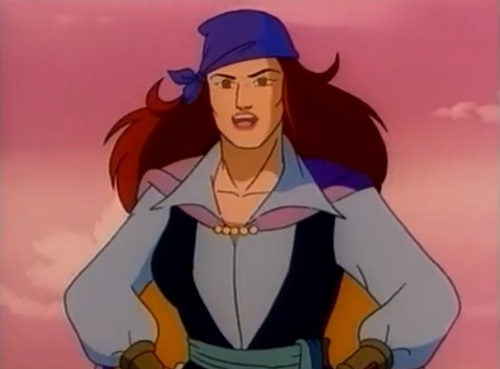
Valeria
I would not say that I recommend the show to any fan’s of Conan or Robert E. Howard but it isn’t bad for what it is. I was happy that it actually had an ending which many cartoons of this type didn’t though all the threads were not resolved and it was typically left open for further episodes. The series does at least capture some of what made the character and his world so attractive and it certainly captured my imagination as a child. The theme song is also pretty cool. The series was released on DVD but is only available used so prices will vary. As I write, the entire series can be viewed here which is where I watched it but I can’t say how long they will stay available.
I don’t intend to cover all the other media available in the world of Conan. This one was special because it was something of a gateway to the original stories. I know it would be tedious to play many of the games which were generally unmemorable excepting the two more recent MMO games. I should lastly mention there is also a live-action Conan the Adventurer series in 1997 which is not related to the cartoon. At a glance, it seems to have been put into production to capitalise on the Hercules and Xena series which were popular at that time. It might be good for a laugh but I don’t intend to find out. As always, even the best of the new stories fall short of Robert E. Howard’s originals and I don’t expect that will ever change.
